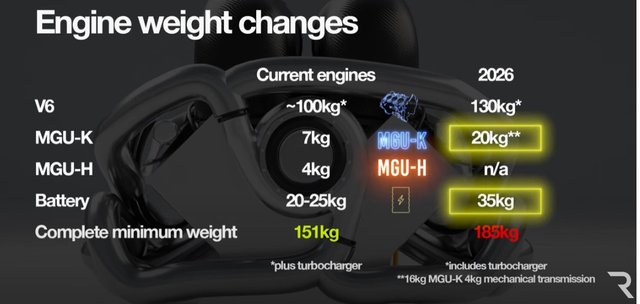Zynerji wrote: ↑07 Jun 2024, 14:33
LionsHeart wrote: ↑07 Jun 2024, 14:26
Zynerji wrote: ↑07 Jun 2024, 14:08
Meh.
Cars are cool-ish, but why ruin it with the hybrid nonsense?
They could have just 1.6l V6 turbo and pushed them to 20k RPM, and would have had a much lighter, cheaper, uncomplicated machine that had more fan appeal.
Removing the VLIM system and such is just nonsense at this point. If they want to go for efficiency, VLIM/VLEM , VVT, VDT, TJI and the rest are all efficiency controllers. Those variables are imperative to getting the most power/RPM. For downsizing at the auto industry level, one would think that developing a tightly packaged power unit that can be tuned to meet any specific vehicle demand would just be a Unicorn that they would chase.
Why rev a turbo engine to 20,000 rpm? In the 1980s, 12,500 rpm was enough to produce over 1,200 horsepower in qualifying mode. Turbo engines usually do not have an extremely high rev because they are more efficient at low rpm due to excess air at the intake. The higher the rpm, the greater the mechanical and thermal losses. No power plant will be able to overcome 7 racing weekends if they spin at 20,000 rpm. And how high will the fuel consumption be? There will be no efficiency.
Ok. I'm talking best of both worlds. The RPM of the 2.4l V8 with the TJI and turbo of the 1.6l V6. Dropping the battery pack and expanding the fuel tank would help lots. Cheap engines means they can do 1 per race and wring them out. And you're correct. Turbo engines with all of the variables mentioned earlier can produce huge torque at low RPM. But that would then be part of the rubric that the teams must overcome, as horsepower overcomes drag, and it has a natural balance point. This is where a defined fuel restriction curve actually makes sense.
The reality of F1 is that most cars are actually good enough to win. It's finding the balance points on a collection of metric tensors that make "magical" races. If it was just easier for the teams to find this balance, the field would close up very quickly.
Ah, okay. I get it. You want to get rid of the battery and the motor generator altogether. In general, maybe that makes sense. But I doubt that it will improve the efficiency of the engine. I think we need to understand what exactly the goal of the FIA and other structures is. What exactly they want. If the goal is to get the maximum possible engine power, then a hybrid is not needed. Please, the V12 or V10 of previous years have enough power. At Monza in the 2000s, they managed to get a speed of over 370 km / h. But if the goal is to get efficient engines, then there is no alternative to a hybrid.
I do not claim to know the truth, but I have some assumptions about what the internal combustion engine will be like in 2026.
So, most likely, the volume of the fuel tank will become smaller, which means that fuel consumption should become lower. By reducing the specific and instantaneous fuel consumption, it means that less air should enter the cylinders. I can only assume the following: the maximum rpm will be lower than now. Let's say 10,000-10,500 rpm. In this case, there is no need for a large turbocharger, which will have greater inertia. MGU-H is no longer there, which means there will be a large turbo lag. It can be reduced by reducing the size of the turbine. The rest should be compensated by MGU-K. How exactly the kinetic energy use map will be implemented, this is what the engine designers will have to decide. I think in general the system should be even more efficient and technologically simple. Perhaps this will even reduce the cost of power unit. And perhaps the resource of power unit will be even greater.

